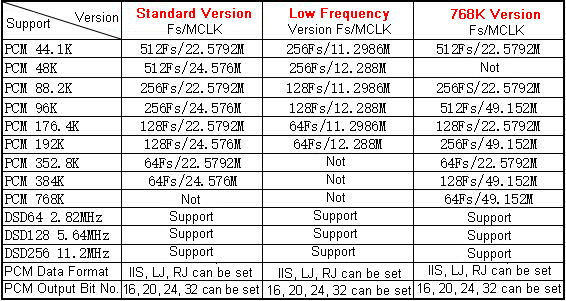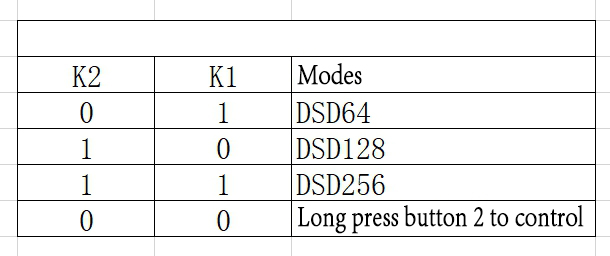AK4137 I2S/DSD Sample Rate Converter Supports PCM/DSD Inter-conversion DOP Input (768K Version)
Description:
AK4137 supports PCM to PCM (convertible sample rate and data format), DSD to DSD (convert DSD sample rate), PCM to DSD, DSD to PCM, DOP to PCM, and DOP to DSD.
Optional Versions:
- Standard version: crystal oscillator 22.5792M 24.576M
- Low frequency version: crystal oscillator 11.2896M 12.288M
- 768K version: crystal oscillator 2.5972M 49.152M
The sample rate of the output function supported by each version is as follows:
 Note:
Note:
- The following details are based on the Standard Version.
Input Signal Range of this Board:
PCM mode can input I2S (16-32bit I2S format is also called format for Philips), LJ (left-aligned format 16-32bit), RJ24 (right-aligned format 24bit, format for Sony), RJ32 (right-aligned format 32bit, format for Sony). Due to the design of the chip manufacturer, signal inputs with right-aligned formats (for Sony) lower than 24 bit are not supported. DSD mode can input DSD64 DSD128 DSD256. and DOP data (DOP data is to be entered in PCM mode).
Output Signal Range of this Board:
- PCM mode can output I2S, LJ (left-aligned format) and RJ (right-aligned format) formats. All three formats can output 16bit, 20bit, 24bit, and 32bit data at 44.1K/48K/88.2K/96K/176.4K/192K/352.8K 384K sample rates, as well as slave mode. DSD mode can output DSD64/DSD128/DSD256.
- Note: The input PCM signal below 44.1K will not convert to DSD, nor will it be converted to a higher sample rate of the PCM. When the input PCM signal is lower than 176.4K, it can output DSD64 DSD128, but cannot output DSD256.
Board Interface Description:
- The POW interface is a power input interface, which do not reverse connection for DC power supply, and the limit voltage is DC 4.6-5.5V (this is only the limit voltage range of the AK4137 board; The voltage range of the display is subject to the display screen used). The I2S/DSD-OUT interface is the I2S/DSD data output interface; I2S/DSD-IN is the I2S/DSD data input interface; D/P is the interface for manual control of PCM/DSD input mode (PCM/DSD input mode can also be controlled through 1 pin of the data input port); The K port is a special function interface; LCDPORT is the display interface (display connection method: pin 1 of the PCB board is connected to pin 1 of the display, the pin 2 of the board is connected to the pin 2 of the display and so on, the middle four pins without pins are not connected).
- Note: When using I2S/DSD-IN interface pin 1 to control the input mode, disconnect the D/P interface.
- There are 4 buttons on the board to set the board (see below for the setting method), in addition to the mute function, other functions set by the button support power-off memory, that is, the board still works according to the last set mode when the next time it is turned on.
- I2S/DSD-IN interface pin definition: pin 1 is DSD enable input (also called DSDON or DSDOE), pin 2 is GND, pin 3 is DATA/DSDL input, pin 4 is BCK/DCLK input, pin 5 is empty pin no connection, and pin 6 is LRCK/DSDR input. This board input interface does not require an input MCLK to work.
- I2S/DSD-OUT interface pin definition: pin 1 is DSD enable output (also called DSDON or DSDOE), pin 2 is GND, pin 3 is DATA/DSDL output, pin 4 is BCK/DCLK output, pin 5 is MCLK output, and pin 6 is LRCK/DSDR output. Pin 1 outputs low level when outputing PCM mode, and pin 1 outputs high level when outputting DSD mode.
Detailed Use Method:
Connect the display screen, etc., turn on the power, connect the POW interface to the 5.0V DC power supply, and the limit voltage is DC 4.6-5.5V (this is the limit voltage range of the AK4137 board; the voltage of the display screen is subject to the display screen used). Reverse connection is not allowed.
Input Setting:
- Set signal input mode: first determine the input signal mode, DSD or PCM (I2S), which can be set via D/P interface. The short-circuited D/P interface input signal mode operates in PCM (I2S) mode, and the disconnected D/P interface input mode works in DSD mode. The input mode can also be controlled through I2S/DSD-IN interface pin 1. When I2S/DSD-IN interface pin 1 is inputting low voltage, it is in PCM input mode, and when the input level is high, it is in DSD input mode. It should be noted that when using I2S/DSD-IN interface pin 1 to control the input mode, the D/P interface must be disconnected (it cannot be short-circuited or it can only work in PCM mode; Short-circuiting may also cause damage to the equipment providing the DSDON/DSDOE signal). When you need to input a DOP signal, you must also configure the input interface to PCM mode.
Set Signal Input Format:
- In PCM input mode, the user can switch the format of the input data by pressing and holding button 1. Each long press of button 1 corresponds to change the format of an input signal, and the input format is displayed correspondingly behind the first line of the letter "I" of the display, with power-off memory function. Input formats include I2S, LJ, RJ24, RJ32, DOP, and loop switching. In DSD input mode, you can switch the input DSD sample rate by long-pressing button 2 and the corresponding display will be displayed after the first line of the letter "I" with power-off memory. DSD inputs include DSD64, DSD128, DSD256, and cyclic switching. It is also possible to switch the input DSD sample rate via K ports K1 and K2 (see table below). It should be noted that when switching the input DSD signal by pressing and holding button 2, the user needs to short-circuit K1 and K2 (let K1 and K2 all be short-circuited, otherwise K1 and K2 will be used to configure the sampling rate of the DSD input). K1 and K2 can automatically switch the DSD sampling rate of the input when used with interface for Amanero (K1 is connected to pin 17 of the interface for Amanero, and K2 is connected to pin 18 of the interface for Amanero).

Attention: 0 is input low voltage (0V), 1 is input high voltage (3.3V).
Output Setting:
- Set output format: Switch the format of the output signal by short pressing button 1. The formats that can be set include I2S, LJ (left-aligned), RJ (right-aligned), DSD64, DSD128, DSD256 and cyclic switching, with power-off memory function and the related display on the second line of the screen.
- Setting the sampling rate of PCM output mode (this function is valid for PCM output mode; the output sampling rate of DSD is switched by short pressing button 1): The sampling rate of the output signal is switched by short pressing button 2. The settable sample rates include 44.1K, 48K, 88.2K, 96K, 176.4K, 192K, 352.8K, 384K, SLA (slave slave mode output) and cyclic switching, with power-off memory and related display on the second line of the screen.
- Setting the number of bits for PCM output mode (available for all PCM data formats): The number of bits for the output signal can be switched by short pressing button 3. The number of bits that can be set includes 16bit, 20bit, 24nit, 32bit (other bits are not supported) and cyclic switching, with power-off memory and related display on the second line of the screen.
Other Settings:
- Digital Filter Settings: Change the digital filter mode by pressing and holding button 3. This setting has power-off memory and digital filter mode will be displayed in the second half of the first line of the screen. The contents displayed are DF1, DF2, DF3, DF4, which correspond to the filter modes in the table below.

- Jitter Settings (add jitter to the signal): set the jitter switch by long-pressing button 4, and turn on the jitter function when the last two digits of the second line of the screen display "DT" after long-pressing button 4, and turn off the jitter after the last two digits of the second row of the screen display "DT" disappears after long-pressing button 4. This function comes with power-off memory.
- Mute Setting: Press button 4 shortly, and when the last two digits of the first row of the screen display "MT", the board is in silent mode. After pressing button 4 again, the "MT" disappears to mean that it is not in mute mode and the audio can play normally. This feature does not have power-off memory. When the system is turned back on, the mute function is canceled.
Button Functions:
- Button 1: Press and hold this button to switch the PCM input format (PCM input mode is valid); Press this button shortly to switch the output mode.
- Button 2: Press and hold this button to change the DSD input sampling rate (DSD input mode is valid); Press this button briefly to change the PCM output sample rate (PCM output mode is active).
- Button 3: Press and hold this button to switch the filter mode; Press this button briefly to change the number of PCM output bits (PCM output mode is active).
- Button 4: After long pressing this button, the button is a jitter switch; After pressing this button, the button is the mute switch.
Electrical Characteristics:
- Power supply: DC5V (AC voltage will cause the board to be damaged) 4.8-5.5V (beyond this range will cause the board to be damaged or not work properly)
- Input signal supports 3.3V and 5V levels; the output signal is 3.3V
- PCB size: 5.2 x 6.3cm/2 x 2.5"
- Using standard 1602 display
- Both crystal oscillators on the board are powered by precision LDOs, and turning off the power of the other crystal oscillator when one of the oscillators oscillator is working can reduce interference.
- In addition to K1 and K2, please try not to use other interfaces for K ports, and consult customer service if you need to use them.
Package Included:
- 1 x Board
- 1 x Display

